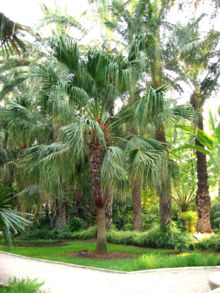Livistona chinensis
| Fountain palm Chinese fan palm | |
|---|---|

| |
| Scientific classification | |
| Kingdom: | |
| (unranked): | |
| (unranked): | |
| (unranked): | |
| Order: | |
| Family: | |
| Genus: | |
| Species: | L. chinensis
|
| Binomial name | |
| Livistona chinensis | |
| Synonyms[1] | |
| |
Livistona chinensis, the Chinese fan palm or fountain palm, is a species of subtropical palm tree of east Asia. It is native to southern Japan, Taiwan, the Ryukyu Islands, southeastern China and Hainan. It is also reportedly naturalized in South Africa, Mauritius, Réunion, the Andaman Islands, Java, New Caledonia, Micronesia, Hawaii, Florida, Bermuda, Puerto Rico and the Dominican Republic.[1][2]
Livistona chinensis can attain heights of about 9 to 15 m (30 to 50 ft) and a spread of 4 m (12 ft). The leaves are fan shaped.[2]
Cultivation
The palm is cultivated as ornamental trees in gardens and conservatories.
This plant can become a weed, or in some ecosystems an invasive species – such as in Florida wetlands and on some Caribbean Islands.
References
- ^ a b c "Livistona chinensis". World Checklist of Selected Plant Families (WCSP). Royal Botanic Gardens, Kew. Retrieved 6 March 2016.
- ^ a b "Chinese Fan Palm". Palm Trees. Archived from the original on 17 March 2012. Retrieved 6 March 2016.
- Bermuda Department of Conservation Services: Invasive Species Profile for Chinese Fan Palm
External links
Wikimedia Commons has media related to Livistona chinensis.
